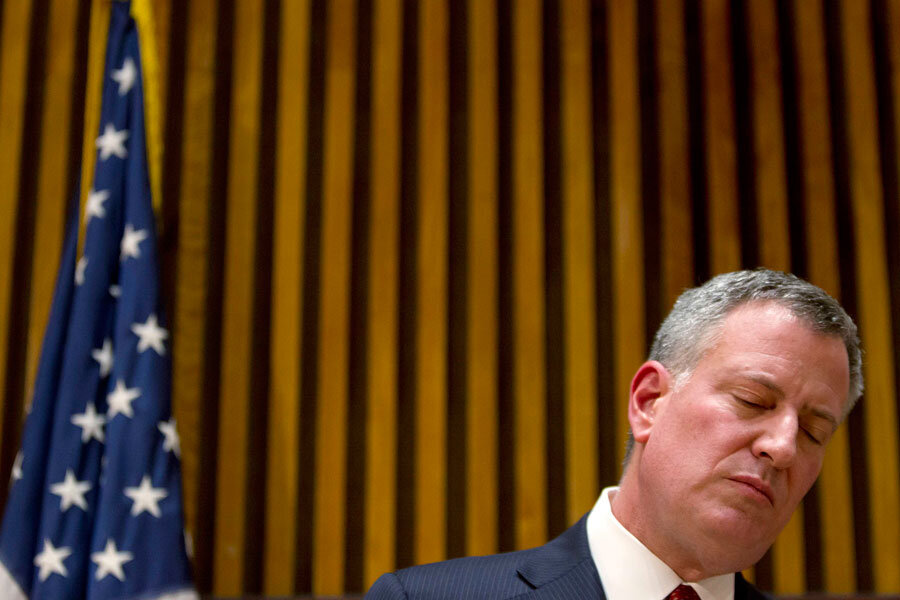With call to 'put aside protests,' New York mayor seeks common ground
Loading...
On Monday, standing beside his police commissioner, New York Mayor Bill de Blasio asked the city to "put aside political debates, put aside protests" until funerals could be held for the two police officers killed Saturday.
Such a pause, he said, was "the right way to try to build towards a more unified and decent city."
Left unsaid, perhaps, is that in the fractious and visceral reactions first to the decision not to indict the cop who killed Eric Garner, and now to the execution-style killing of two police officers on a Brooklyn street corner, silence and calm have seemed in short supply.
Mayor de Blasio's request Monday in some ways came across as a plea for a cease-fire.
On Sunday, former New York Mayor Rudolph Giuliani suggested that the Saturday shootings were an outgrowth of an anti-police fervor stoked by the protests and President Obama. New York police union leader Patrick Lynch said there was "blood on the hands" of City Hall for not stepping in, and former NYPD Commissioner Howard Safir wrote in Time magazine of "an atmosphere of permissiveness and anti-police rhetoric unlike any that I have seen in 45 years in law enforcement."
The pendulum of public outrage, so recently with the protesters saying that police were being held above the law, had swung quickly and decidedly.
But Monday, the mayor spoke with stubborn optimism: "There's never been a doubt in my mind that we’re working towards a day that there is greater harmony between police and community."
"In due time," he said, the city would again talk about the issues raised by a tumultuous December. The hope must be that, by then, some of the voices might have adjusted the volume.
Already, some activists and commentators are seeking to reclaim the vast middle ground of the debate.
DeRay McKesson, a leader of protests in Ferguson, Mo., offered thoughts that were retweeted nearly 9,000 times Saturday.
In the charged atmosphere, where both police and civilians have been killers and victims, misunderstood and maligned, tragedy has at times led people on both sides to talk past each other. On one side, many police see calls for reform as a thin veneer for disrespect. On the other, many in the black community see claims of self-defense as as rationalization for lingering racism.
But the solution is in neither of these extremes, wrote Conor Friedersdorf in The Atlantic Monday.
"The murder of Officers Liu and Ramos is an outrage, a tragedy, and an illustration of why rhetoric urging violence against police officers is wrongheaded and inappropriate," he said. "It is also a kind of anti-police attack that is thankfully rare, and in no way diminishes the need for reforms like body cameras, the demilitarization of police departments, training and procedures that emphasize de-escalation and alternatives to deadly force, and employment contracts that prevent arbitrators from reinstating cops fired for incompetence."
Jamelle Bouie of Slate argues that the two points of the debate are not mutually repellant. "The people demonstrating for Eric Garner and Michael Brown aren’t against police, they are for better policing," he wrote. "When criminals kill cops, they’re punished. But when cops kill citizens, the system breaks down and no one is held accountable. That is what people are protesting."
Portraits of the two slain officers, Wenjian Liu and Rafael Ramos, have helped put a human face on a profession that has been under increasing attack in recent months. Officer Liu got married just three months ago and, according to The New York Times, told a friend that he was a police officer, despite the dangers, because “If I don’t do it and you don’t do it, then who is going to do it?”
Officer Ramos had two sons, one who is 13 and another who is a sophomore at Bowdoin College, and had recently worked as a school safety officer.
And civil rights leaders – including Al Sharpton and the parents of Eric Garner – have been quick both to condemn the killings and to plead with those who are angry over police brutality and the deaths of Garner and Mr. Brown not to respond with violence.
Ismaaiyl Brinsely, the man who allegedly shot the officers, was an individual with a history of violence, who had already shot his ex-girlfriend earlier in the day and killed himself shortly afterward, activists point out. The bulk of protests have been nonviolent and focused on specific reforms, not "anti-cop," they add.
While police officers are worried that the Brinsley's killings portend more violence toward police, the most recent FBI statistics show that fewer law-enforcement officers are killed in the line of duty – 27 in 2013 – than has been the case in decades.
That doesn't mean police concerns are overblown. Mr. Friedersdorf raised questions about how Mr. Brinsely was apparently able to write freely on social media about a desire to kill cops. "One can't help but wonder if Brinsley would've thought better of his subsequent actions had his social-media followers objected to his threat or expressed disapproval rather than vague encouragement."
But writing in Reason on Monday, Ed Krayewski took issue with the New York cops calling theirs a "wartime" police department. "Things like greater accountability and transparency, independent investigations, and more substantive disciplinary reforms aren't 'anti-cop.' They're good for police and the people being policed."








